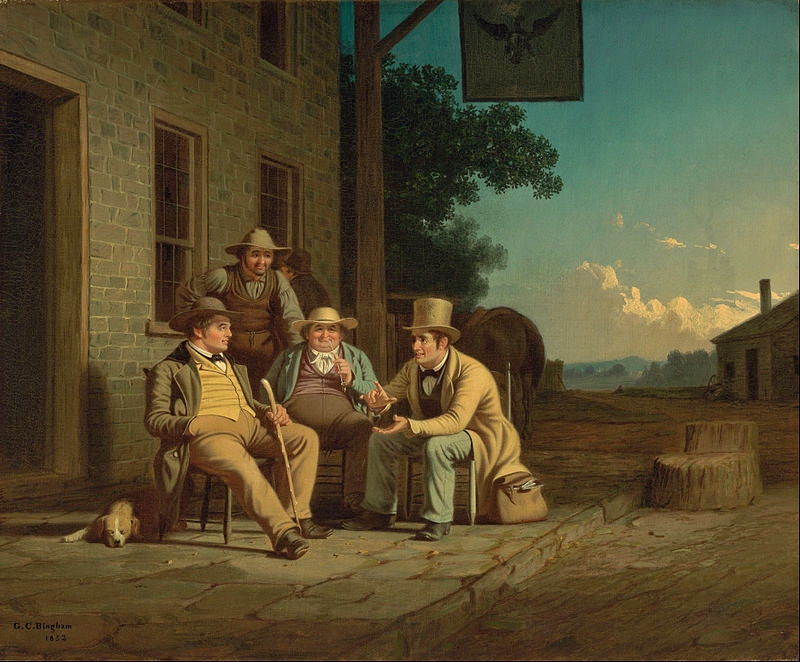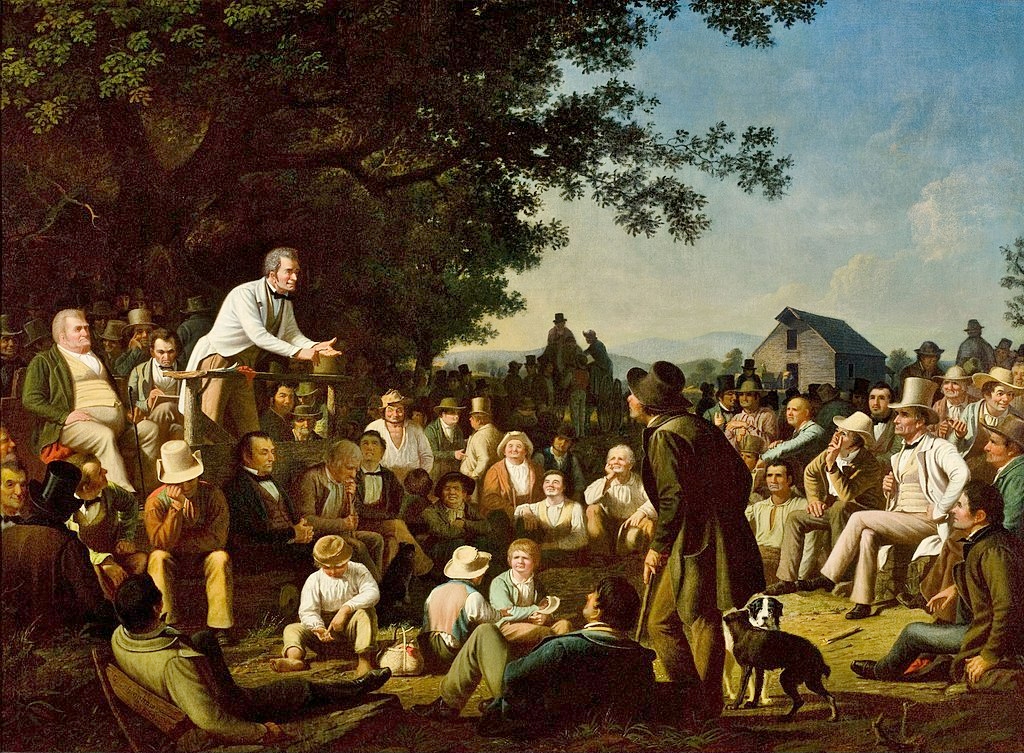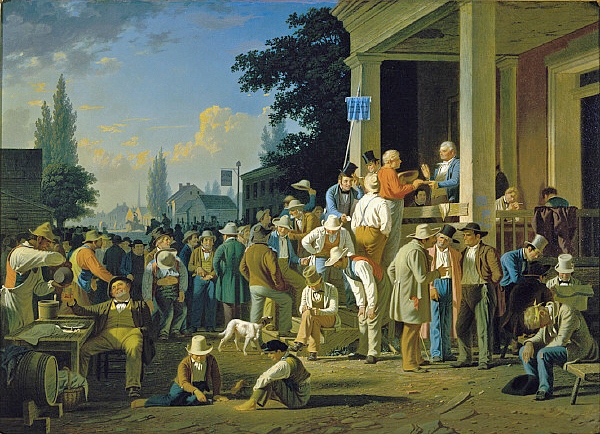George Caleb Bingham (1811-1879) is a well-known American painter of jolly boatmen who transported furs and other cargo on rafts along the Missouri and Mississippi Rivers. He also painted several portraits. He is lesser-known as a politician and soldier. His political paintings convey his strong belief in Democracy with all its flaws and that slavery was immoral and a threat to the future of the Union.
He was born in Augusta County, Virginia. When the family lost their mill, they moved to Missouri. Bingham was educated by his mother. He was mostly a self-taught painter. By age nineteen he was painting portraits for $20; by age twenty-two he supported himself with his art. He opened his first studio in 1838 in St. Louis. He moved to Philadelphia to study at the Pennsylvania Academy of Art, but he remained there only for three months before moving to Washington, D.C., where he studied with Benjamin West and Thomas Sully from 1840 until1844. Bingham married his first wife, and they moved in 1845 to Arrow Rock, Saline County, Missouri. Their home is now a National Historic Landmark.

“Canvassing for a Vote” (1852)
Bingham became involved with politics as early as 1840, during the race for president between Martin Van Buren and William Henry Harrison. Over the next several years he painted six canvases in his “election series.” “Canvassing for a Vote” (1852) (25”x31”) (Nelson Atkins Museum, Kansas City, MO) is one of the earliest. In front of the Arrow Rock Tavern, in his hometown, Bingham poses five men, a sleeping dog, and a horse’s rump, all within a triangular composition.
The candidate wearing a top hat, explains his position to the city gentleman with the cane, the country gentleman smoking his corn cob pipe, and the worker in the leather apron. The fifth man turns his back on the conversation; either he does not care, or he opposes the candidate’s thinking, or he could represent those who felt disenfranchised. These attitudes were prevalent at the time. Historians and art critics suggest that the sleeping dog may represent voters’ lack of enthusiasm, or the attitude toward the issue of slavery by the Missouri Legislation: “Let sleeping dogs lie.” One other idea has been proposed, that the approximate placement of the head of the candidate and the horse’s rump may represent Bingham’s estimation of politicians. Nevertheless, he knew the value of democracy, even with its flaws. Bingham ran as a Whig for the Missouri House of Representatives in 1848. The initial count resulted in three votes in his favor. He lost the recount and suspected vote tampering. He ran in the following year and won by a large margin.

“Stump Speaking” (1853-54)
“Stump Speaking” (1853-54) (43”x58’’) is a depiction of a politician trying to persuade a group of Missouri citizens to vote for him. The three figures dressed in white form a wide triangle. They are Bingham’s key to the painting. The Stump Speaker represents the current issues to be decided, and he reaches out to the crowd. The Outstanding Citizen, as Bingham refers to him, wears a white suit and top hat, and he sits across from the Speaker. He leans forward, one hand on his hip, and listens to the Speaker. He represents the past, and he is rigid is his opposition. The future is represented by the young, bare footed boy in the white shirt. He sits at the front of the composition. Both hands in front of him, his finger points into the palm of the other hand as he counts some coins.
The group of citizens includes men, women, and children of various ages and means. All are white. They surround the Speaker and sit or stand in natural positions. Bingham includes several portraits. The Stump Speaker resembles Erasmus Sappington, Bingham’s opponent in the previous election. The older, rotund figure wearing the green jacket resembles Meredith Marmaduke, the former governor of Missouri. The figure next to him is a self-portrait of Bingham, head down as he takes notes.

“The County Election” (1852)
“The County Election” (1852) (38”x52”) was the first painting in Bingham’s election series. Male citizens of all ages gather at the polling place. The inscription “The Will of the People, The Supreme Law” on the blue banner represents the artist’s belief. The scene is set outdoors in the light of day so that everyone could witness the vote. At the top of the stairs, the man in the orange shirt swears on a Bible that this is his only vote. Behind him on the stairs, the man tipping his top hat may be offering a bribe to the next voter. At the bottom of the stairs to the left, another man in a top hat drags a limp man, possibly drunk, toward the stairs so that he can vote. At the far right a drunk sits hunched over, his head bandaged, perhaps suggesting that elections could result in violence.
Behind the drunk, two men read a newspaper The Missouri Republican. When Bingham made a print of the painting, he had the title changed to The National Intelligencer to appeal to a broader audience. At the left front of the work, a man sits and drinks beer. Votes bought by liquor were common in the 19th and early 20th Centuries. Two boys play mumblety-peg with a knife. With splayed fingers, the boys stab between them as quickly as they can without cutting themselves.

“The Verdict of the People” (1854-55)
“The Verdict of the People” (1854-55) (46”x55”) was the last painting in Bingham’s election series. The crowd gathers in front of the courthouse to learn the election results. Bingham’s usual set of characters include farmers, laborers, politicians, and immigrants. However, he has included women and African American slaves. The African American pushing a wheelbarrow is prominently placed in the left foreground of the painting. The presence of women is not as obvious. White and African American women look on from a balcony at the top right. None has the right to vote.
“The Verdict of the People” is a depiction of two prominent issues in the 1854 election. Herman Humphrey’s book of 1828, Parallel between Intemperance and Slavery, explored the idea that alcohol and slavery were linked. The American Society of Temperance had been founded in1826, and the idea of abolishing alcohol was taking hold in several states by the 1850s. Bingham’s views were always anti-slavery; however, he considered abolishing alcohol to be wrong.
Bingham sent his election series to Washington, D.C., with the hope that the Library Committee of Congress would purchase the paintings. He wanted Americans to see his work and understand his ideas. The Library Committee of Congress did not purchase them. Bingham then lent them to the Mercantile Library Association in St. Louis, Missouri.
Abaham Lincoln was elected president in1861. Bingham was on the side of the Union during the Civil War; he fought and raised troops. The government of Missouri declared itself against slavery. The governor appointed Bingham to serve as Missouri State Treasurer in 1862. After the Civil War, Bingham was appointed President of the Kansas City Board of Police Commissioners. He became the first Chief of Police. He never stopped painting.
“To the beautiful belongs an endless variety. It is seen not only in symmetry and elegance of form, in youth and health, but is often quite as fully apparent in decrepit old age. It is found in the cottage of the peasant as well as the palace of kings.” (George Caleb Bingham)
Beverly Hall Smith was a professor of art history for 40 years. Since retiring to Chestertown with her husband Kurt in 2014, she has taught art history classes at WC-ALL and the Institute of Adult Learning, Centreville. An artist, she sometimes exhibits work at River Arts. She also paints sets for the Garfield Theater in Chestertown.



Write a Letter to the Editor on this Article
We encourage readers to offer their point of view on this article by submitting the following form. Editing is sometimes necessary and is done at the discretion of the editorial staff.